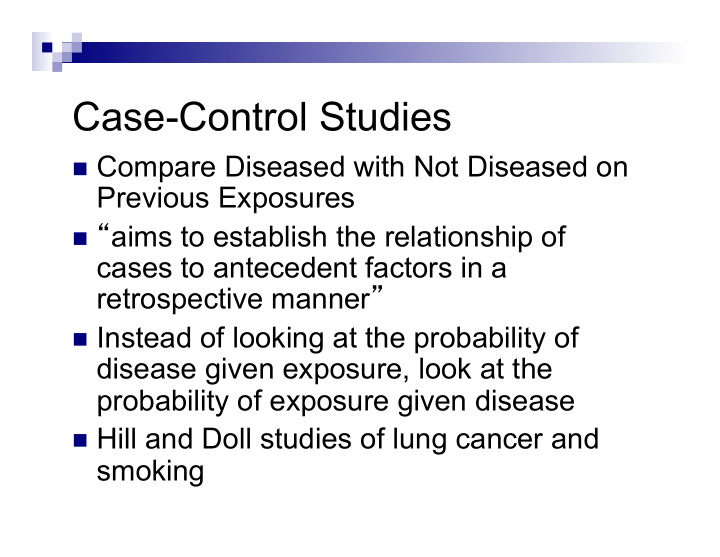



Case-Control Studies n Compare Diseased with Not Diseased on Previous Exposures n “ aims to establish the relationship of cases to antecedent factors in a retrospective manner ” n Instead of looking at the probability of disease given exposure, look at the probability of exposure given disease n Hill and Doll studies of lung cancer and smoking
Advantages n Cost n Time n Rare Diseases n Diseases with long latency periods n IDs (CDC)
Disadvantages n Temporality ¨ Did exposure actually precede disease? ¨ Difficult to quantify level of exposure ¨ Better if rapid onset disease n Control Group – crux of the problem ¨ “ the control series is intended to provide an estimate of the exposure rate that would be expected to occur in the cases if there was no association ” ¨ study base “ the most frequently used source of controls is people seeking care at the same (hospital) for other diseases ” n Recall Bias
Anatomy of a Case-Control Study Underlying Cohort
Analysis of Case Control Studies: The Odds Ratio n Prospective vs. Retrospective Approach ¨ Cohort studies: Pr[D|E] e.g. Pr[CA|Smoking] ¨ Case-control: Pr[E|D] e.g. Pr[Smoking|CA] Are they measuring the same thing?
Smoking and Lung Cancer LUNG CANCER SMOKING Yes No Yes 100 900 1000 No 50 1950 2000 150 2850 3000 Pr[D|E] = 100 / 1000 = 0.10 Pr[E|D] = 100 / 150 = 0.66
Need for a New Measure of Effect n Recall: Odds related to Probability (Risk) ¨ Odds = Probability/1 – Probability (And Probability = Odds / 1+ Odds) n 1:1 transformation; W = odds of A occurring, then p= P[A] = W / W +1, e.g. if odds = 2:1, probability = 2/3; if the probability = 0.75 (3/4) then the odds = (3/4) / (1/4) = 3:1 n ODDS = Pr[D] / Pr[d] = Pr[D] / 1 – Pr[D] n ODDS RATIO = Odds in Exposed Odds in Unexposed A way for us to get at risk retrospectively …
Calculating The Odds Ratio D d n OR = ad/bc E 100 900 n Lung CA example, OR = (100) (1950) / (900)(50) = 5.0 e 50 1950 n RR= 100/1000 / 50/2000 = 4.0
Derivation and Invariability of the Odds Ratio n Exposure Odds Ratio (Pr E|D / PrE|d) n P[E | D ] / P[e | D] = P[E | D ] / 1 - P[E | D ] = (a/a+c) / (c/a+c) n P[E|e] = P[E | d] / P[e|d] = (b/b+d) / (d/d+c) n OR = [(a/a+c) / (c/a+c)] / [(b/b+d) / (d/d+c)] = (a/c) / (b/d) = ad/bc n Disease Odds Ratio (Pr [D|E] / Pr[D/e]) n P[E | D ] / P[e | D] = P[E | D ] / 1 - P[E | D ] = (a/a+c) / (c/a+c) n P[E|e] = P[E | d] / P[e|d] = (b/b+d) / (d/d+c) n OR = [(a/a+c) / (c/a+c)] / [(b/b+d) / (d/d+c)] = (a/c) / (b/d) = ad/bc
Rare Disease Assumption n The OR will approximate the RR if the D d disease is “ rare ” E A B n Few people die from D, don ’ t contribute much P-Y to denominator n ‘ a ’ cell small relative to ‘ b ’ ; ‘ c ’ e C D small relative to ‘ d ’ n RR = (a/a+b) / (c/c+d) ~ (a/b) / (c/d) = ad/bc = OR
Cross-Sectional Studies n All there was at time of epidemiologic transition n Exposure and disease ascertained simultaneously; individual level data n Inexpensive and simple n Problems and Biases ¨ Directionality ¨ Incidence – Prevalence Bias n E.g. mouthwash and oral CA ¨ Recall Bias
Evans County, GA. CORNOARY NO TOTAL ARTERY CORONARY DISEASE ARTERY DISEASE PHYSICALLY 14 75 89 ACTIVE NOT 3 87 90 PHYSICALLY ACTIVE TOTAL 17 162 179 Relative Risk = (14/89) / (3/90) = 4.7
Problems and Biases n Directionality ¨ Mouthwash and Oral CA ¨ Hip Fx and Obesity ¨ CAD and Activity n Incidence – Prevalence Bias ¨ More likely to pick up chronic cases ¨ Evans County: CAD Prevalence higher in whites vs. blacks n Recall Bias ¨ Birth defect studies
Ecologic Data vs. Individual- Level Data n A. Ecologic Studies (proportions, percentages) ¨ Advantage – cheap, easy, fast, new hypotheses, to study group-level attributes ¨ Problem – ecologic fallacy n B. The Ecologic Fallacy ¨ Aristotle ’ s “ fallacy of division ¨ “ the assumption that an association at one level of organization can be inferred from that at another ” ¨ “ cross-level ” analysis ¨ E.g. Durkheim, Robinson, Lung Cancer and pollution
We don ’ t know the cells, only the marginals: Disease No Disease Total Exposed ? ? A+B Not ? ? C+D Exposed Total A+C B+D A+B+C+D = total
Ecologic Fallacy n Durkheim ¨ Suicide rates in Prussian provinces strongly correlated to proportion of Protestants (8X ↑ ) ¨ Individual data è risk ↓ to 2X n Robinson ¨ Literacy ¨ r=0.62 areas with many recent immigrants
Design Features of Ecologic Studies ¨ Unit of Analysis the group (often defined geographically) ¨ Data more readily available ¨ Inexpensive, quick, can generate useful hypotheses ¨ Often only way to study group-level variables ¨ Correlations often much higher than those seen in individual-level studies ¨ Does disease occur in exposed? (fallacy)
Recommend
More recommend